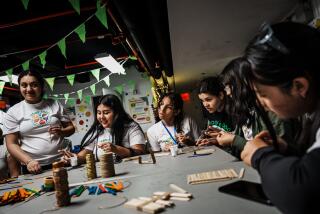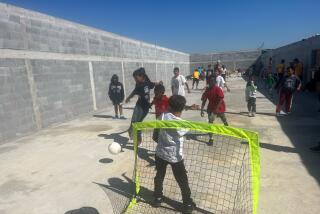Column: Girl Scout’s project provides hope through hoops
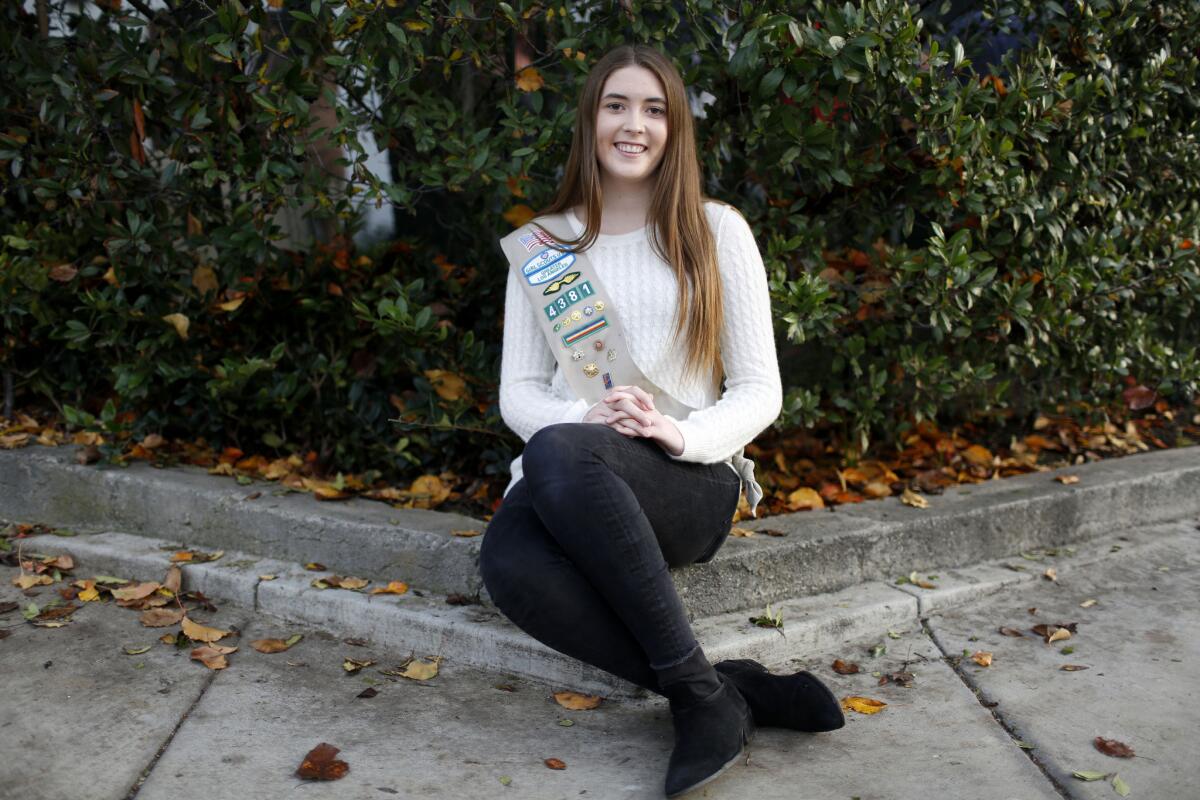
Claire Dundee spent countless hours organizing a basketball court construction project that required nearly three weeks at a donated cost of about $25,000.
The Girl Scout stands shyly on the grassy edge of what, at this moment, is quite possibly the happiest concrete slab in Los Angeles.
It is a basketball court. Not a full court, not even a half court, but enough of a court to hold fallaway jump shots, drives down the lane, and heaps of laughter loud enough to drown out the cars whooshing through the cluttered city streets.
It is a Thursday after school, and a bunch of kids are joyfully and fearlessly running around the shiny adjustable basket and its nylon net as if they had just emerged from behind locked doors into a long-awaited embrace of endless fresh air, which they have.
The court is located in the secluded front yard of a Door of Hope transitional apartment complex for women and children who have been left homeless as a result of domestic violence. The center’s location cannot be revealed for security reasons. The 18 children who reside in the 13 apartments in this building can rarely play outside the complex, also for security reasons.
This court is their private refuge, their daily release, a place one can soar and sprint and shout and still be safe. It has been open only a month yet is already filled every afternoon with kids who can bond over their heartaches and share their dreams.
All of which makes the Girl Scout look lost. A stray ball rolls to her feet. She bends down and gently tosses it back to the crowd of kids and now they’re staring like, what is she doing here?
It was my favorite part of the project, seeing the kids fight over the balls and run out there and just start shooting.
— Claire Dundee, after cutting the ribbon on a new basketball court at Door of Hope
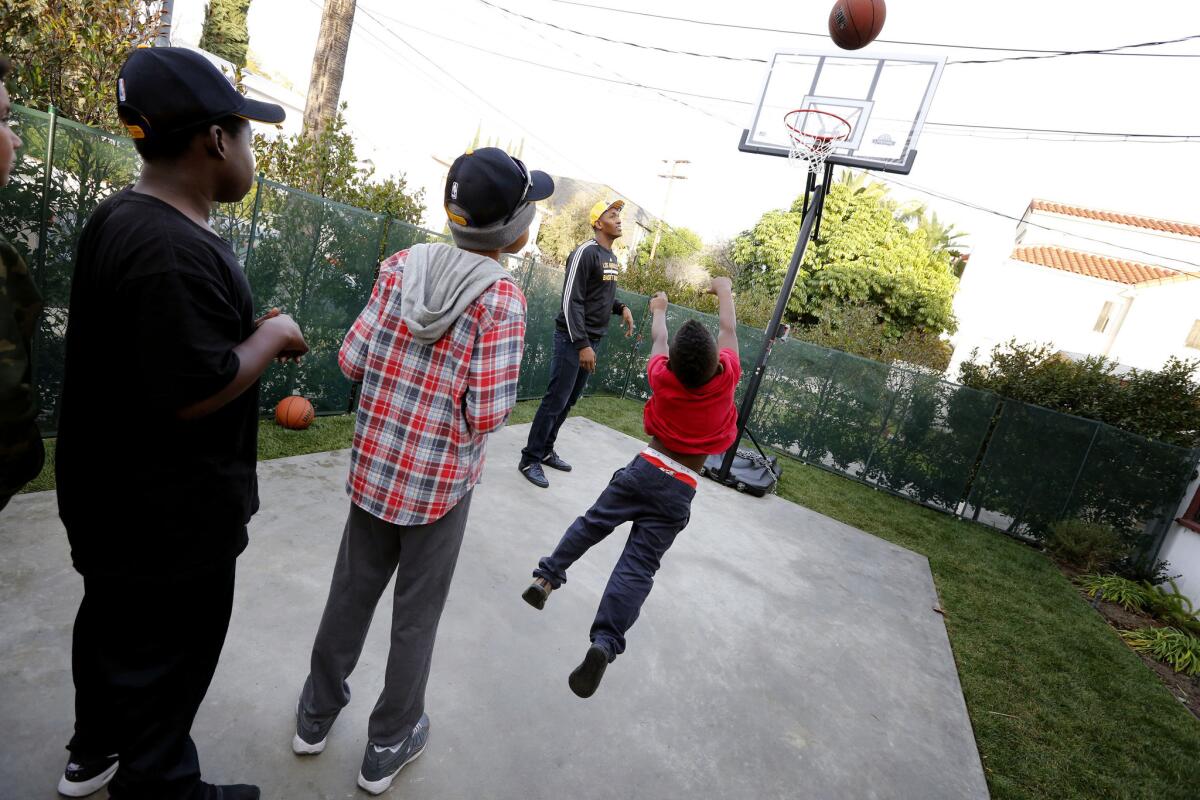
Children play on the newly constructed basketball court, along with Lakers forward Metta World Peace, who is near the basket, at the Door of Hope transitional apartment complex for women and children who have been left homeless as a result of domestic violence.
She doesn’t live here. She no longer plays basketball. She barely even watches basketball. She’s 16 years old and standing there wearing one of those little-girl sashes filled with patches and buttons.
“I know, I know,” Claire Dundee says with a smile. “People say, ‘You’re still a girl scout? Isn’t that for second graders?”’
Also, apparently, for giants.
The Girl Scout is here not because she’s trying to earn a badge by passing out water, leading cheers, or arranging a postgame ice cream social.
The Girl Scout is visiting the basketball court because she built it.
With her wits and will, during a six-month period that occasionally seemed like forever, Claire Dundee arranged and supervised the construction of a simple court that has been the answer to endless prayers. She initially did it to earn her Girl Scout Gold Award, that organization’s highest honor, but eventually reaped far greater riches, restoring faith in adults skeptical of a teen’s determination and hope in kids who didn’t have a place to play.
She raised the money, convinced the contractor, dealt with the architect, eventually even pushed the wheelbarrow. In the beginning, she was so scared to phone strangers that she would write down a script before every call. But by the end, she was overseeing the pouring of the concrete.
On this recent Thursday afternoon, as Dundee’s vision leaps and twirls through gangly boys and toddling princesses, Shaina Clasberry, youth coordinator for Door of Hope, shakes her head.
“That Girl scout did way more than sell us cookies,” she says.
::
From the time she threw a ball at a hoop while sitting atop her father’s shoulders, Claire Dundee realized that a basketball court wasn’t really about basketball.
“For me, it was about bonding, sharing, becoming a family,” she said.
She and her father and brother would spend long afternoons at the hoop in front of their La Cañada home, competing and chatting, keeping score in the usual playground ways.
“I would judge myself by the lines on the concrete,” she recalled. “Each year, I would try to make shots from a line that was farther from the basket.”
Occasionally she would shoot a ball over the fence into the neighbor’s yard. The ball would be returned after being punctured by the neighbor, who would attach a note warning against further intrusions.
“We would just get another ball and keep shooting,” she said. “I couldn’t imagine never being able to play whenever I wanted.”
Last spring, while looking for ideas for her Gold Award, that imagination was sparked when she met with officials from Door of Hope, which provides short-term housing for homeless families and children at three facilities in the Los Angeles area.
Dundee was given some of the usual options involving things like building bookcases or planting bushes. When those notions seem to bore her, one of the employees threw out a completely crazy idea: If Dundee really wanted to help, she could turn one of their building’s dusty yards into a basketball court.
“It’s a huge need for us to have a space for children to have a safe place to play,” said Tim Peters, executive director of Door of Hope. “For kids going through trauma, to be able to do kid things, that’s such a big thing.”
Peters never imagined that the children’s space could actually be constructed by a child.
“We were quite apprehensive whether this Girl Scout could tackle that big of a project,” he said.
Their apprehensions were noted. The worries of her parents were heard.
Said her father Vince: “I was like, are you sure you know what you’re getting into?”
Said her mother Judy: “It was unlikely somebody could do it. But Claire lit up about it.”
Dundee indeed called everyone’s bluff, and her aptly named project “Hoops of Hope” was born.
“A lot of people said I was crazy,” she recalled. “But I knew something like that would last forever.”
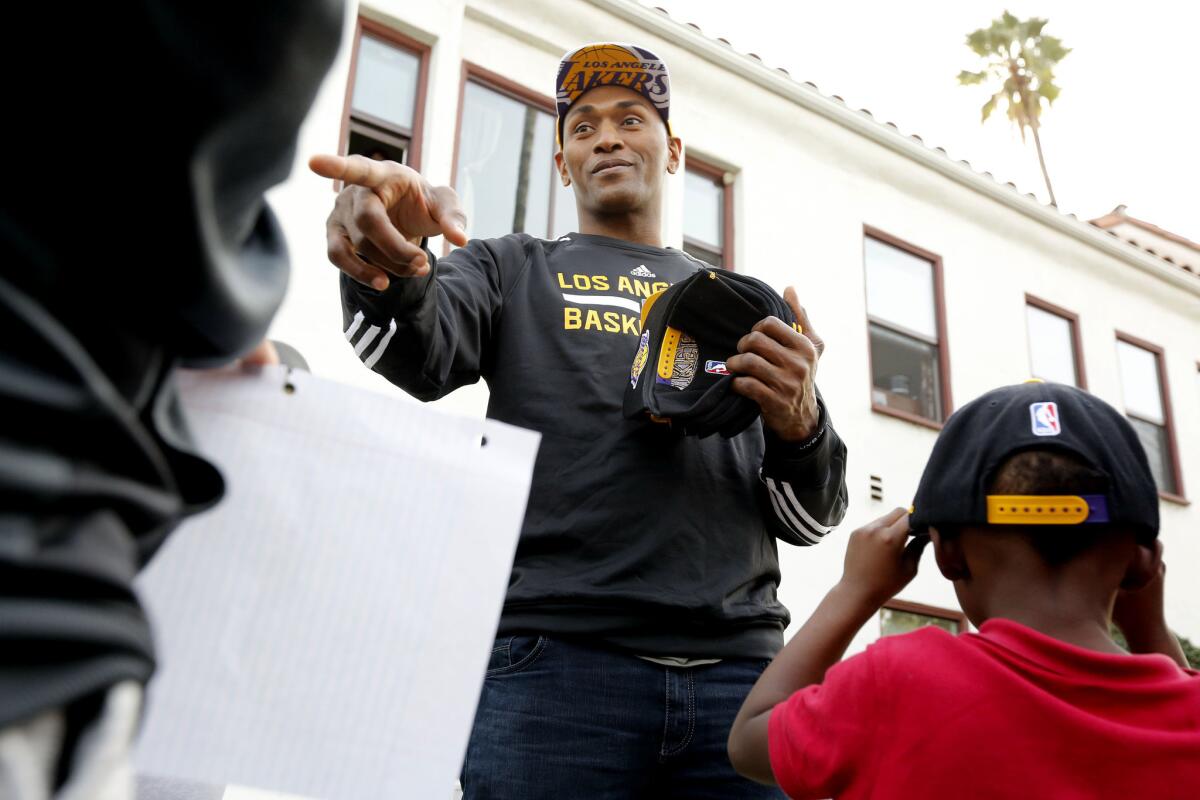
And after all, how hard could it be? Raise some money to buy a goal and some balls, get a contractor to donate a concrete slab, no big deal. She could surely finish it during the summer before embarking on her junior year at Flintridge Prep, right?
Not so fast. Quickly, Dundee discovered that there was nothing in the Girl Scout manual that could guide her through dealings with everything from city hall to a cement mixer.
“Pretty soon it became obvious that this was going to be overwhelming,” she said.
She collected boxes of junk from friends and held a giant rummage sale in a vacant lot. She made $1,700. She needed more. She personally called everyone’s parents she knew, read from her script and begged them for donations. She collected another $2,000. She could now buy equipment and help supplant the labor donation of a volunteer contractor.
She thought the hard part was over. She was wrong.
It turns out, the city had specifications that had to be handled by the building’s owner and architect. The city wasn’t wild about putting a half-sized basketball court in anybody’s front yard. The emails and phone calls kept piling up with little results.
“We thought, this could be great, but there’s going to be some big hurdles here,” said Mark Trueblood, a board member of the Verdugo Housing Corporation that owns the building. “Claire was very impressive, but I think this was less than a 50-50 proposition.”
Yet Dundee stayed up late every night sifting through emails and poking and prodding and reminding everyone of the importance of their mission. Through this inspiration, Trueblood and Richard Dell, principal of the RED Architectual Group, continued to push officials until they finally relented.
Said Dell: “I was blown away by her vision. We’re always so focused on fixing the building, and she was like, ‘Wait, we need something fun for kids.”’
Said Trueblood: “Claire hung on and wouldn’t let go.”
Now she just needed to actually build it. The initial contractor failed to show up, so another script was written, another phone call was made, this time to a contractor who had previously done some business with her father.
“That’s the first time I’ve ever met a Girl Scout,” recalled a chuckling Mansour Jahanbin of Irvine-based Oxford Construction. “I was so impressed to see her coming at me from so far outside the box. It’s amazing that a 16-year-old girl would think like that.”
The project required nearly three weeks, with five workers, at a donated cost of about $25,000, and was run by a most unusual foreman. Dundee would show up every day after school to check on everything from grading to concrete while pulling weeds and planting bushes.
“She was my boss,” Jahanbin said. “It was one of those projects that you start at a certain level, and it keeps getting bigger, but it was such a good thing, and she was so impressive, you can’t stop, you’ve got to finish it.”
Finally, on Dec. 22, in a light rain, a ribbon was cut and a dozen kids splashed out to the court to celebrate its creation. Of course, for the occasion, the Girl Scout brought cookies. Only this Girl Scout baked them herself.
“It was my favorite part of the project, seeing the kids fight over the balls and run out there and just start shooting,” Dundee recalled. “I just stood back and watched. It was really something.”
Considering the amount of young pain that they see coming across their threshold every day, the Door of Hope folks were even more impressed.
“It’s amazing that a kid can have an idea and end up serving other kids in the community,” said Nicole Peters, development associate of Door of Hope. “It gives me faith in humanity.”
Yet the Girl Scout has stayed in the background, no initials carved in the concrete, no plaque anywhere, Dundee leaving no personal mark on the court other than her sweat. In fact, she says she’s not even finished, as she insists on painting the court green and adding official lines once it dries from the recent rains.
“It doesn’t matter if I did it, it matters that it’s there,” Dundee said. “That’s all that’s important.”

Her impact could be found Thursday in an 11-year-old named Arman, who had been running up and down the small court with huge beads of sweat and a tired smile.
“Before this, I would be in my apartment, bored, doing nothing,” Arman said. “Now I can get out all of my Laker gear and wear it and play in it. Now it’s like I’m really home.”
On another part of the court, Susana, a current resident, said Dundee’s influence was visible in the expression of her 11-year-old son Jonathan.
“I can see a smile on his face, a change in him, he can come downstairs and just play and be a kid,” she said. “Who knew a court could be so important?”
Standing quietly on the sidelines of her wonderfully raucous miracle, with a grin as sweet as a thin mint, the Girl Scout knew.
Follow Bill Plaschke on Twitter: @billplaschke
More to Read
Go beyond the scoreboard
Get the latest on L.A.'s teams in the daily Sports Report newsletter.
You may occasionally receive promotional content from the Los Angeles Times.

